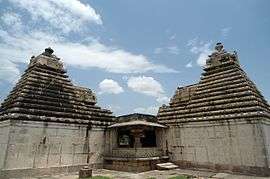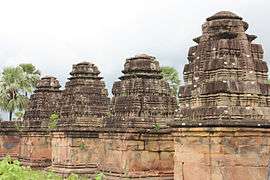Sammakka Saralamma Jatara
| Sammakka Saralamma Jatara | |
|---|---|
|
Sammakka gadde at Jatara | |
| Observed by | Tribal people or Scheduled Tribes |
| Type | Hindu, Tribal |
| Celebrations | 4 days |
| Observances | Offering to the Goddess |
| Date | Biennial |
Sammakka Saralamma Jatara or Medaram Jatara is a tribal festival of honouring the goddesses celebrated in the state of Telangana, India. The Jatara begins at Medaram in Tadvai mandal in Warangal district.[1]
Medaram is a remote place in the Eturnagaram Wildlife Sanctuary, a part of Dandakaranya, the largest surviving forest belt in the Deccan.
Jatara is celebrated during the time the goddesses of the tribals are believed to visit them. It is believed that after Kumbha Mela, the Medaram jatara attracts the largest number of devotees in the country.
It commemorates the fight of a mother and daughter, Sammakka and Saralamma, with the reigning rulers against an unjust law.
There are many legends about the miraculous powers of Sammakka. According to a tribal story, about 6-7 centuries ago, that is in the 13th century, some tribal leaders who went for a hunting found a new born girl (Sammakka) emitting enormous light playing amidst tigers. She was taken to their habitation, and the head of the tribe adopted her and brought up as a chief. She later became the saviour of the tribals of the region. She was married to Pagididda Raju, a feudatory tribal chief of Kakatiyas (who ruled the country of Andhra from Warangal City between 1000 AD and 1380 AD). She was blessed with 2 daughters and one son namely Sarakka, Nagulamma and Jampanna respectively.[2]
Sammakka Sarakka Jatara is a Hindu tribal festival, held at about 100 km from Warangal city. It is the time for the largest tribal congregation in the world, held every two years (biennial), with approximately ten million people converging on the place, over a period of four days.[3] Many tribal devotees from different states of India (Madhya Pradesh, Chhattisgarh, Orissa, Maharashtra, Karnataka and parts of Jharkhand) reach to the festive place to celebrate the Jatara.
People offer bangaram/gold (jaggery) to their weight to the goddesses and take holy bath in Jampanna Vagu (stream). It is a festival with no vedic or brahmanic influence.
In 2008, nearly 8 million people were estimated to have attended the festival. And in 2012, the gatherings in the jatara are roughly estimated to be 10 million. This fair is said to be the largest repeating congregation of tribal communities in the world.
Festival held in 2016 is the first one after the formation of Telangana state, and it took a greater significance with special attention by the government.[4]
| Year | Month | Dates | Reference |
|---|---|---|---|
| 2010 | January | 27 – 30 | |
| 2012 | February | 08 – 11 | [5] |
| 2014 | February | 12 – 15 | |
| 2016 | February | 17 – 20 | [6] |
Jampanna vagu is a tributary to river Godavari. According to the history, Jampanna is the tribal warrior and the son of tribal Goddess Sammakka. The Jampanna vagu took his name as he died in a battle fighting against Kakatiyan Army in that stream. The Jampanna vagu is still red in colour marked with the blood of Jampanna (Scientifically the red colour of the water is attributed to the soil composition). Tribal's believe that taking a holy dip in the red water of Jampanna Vagu reminds them the sacrifice of their gods who save them and also induces courage into their souls.
There is a bridge constructed on top of Jampanna Vagu, known as Jampanna Vagu bridge.
The jatara venue is situated at about 100 km from Warangal, and 250 km from Hyderabad.
Until 1978, the only way to reach Medaram was by a bullock cart. In 1978 the state government declared the 1000-yr old festival as official and laid down a motorable road. TSRTC runs multiple buses to the venue during the jatara period. Also, many private vehicles render their services for plying the visitors.
Jatara is very well facilitated with roads, drinking water, sanitation, health and hygiene by the Government of Telangana.[7]
References
- ↑ "Sammakka Sarakka jatara 2016 Dates". TSI. October 9, 2015.
- ↑ http://www.thehindu.com/features/friday-review/history-and-culture/tribal-festival-gets-bigger/article8280562.ece
- ↑ "Sammakka Sarakka jatara begins". The Hindu. February 16, 2006. Archived from the original on March 19, 2008.
- ↑ "Medaram Sammakka saralamma Jatara 2016 Live". TRV News. Retrieved 2016-02-16.
- ↑ http://timesofindia.indiatimes.com/city/hyderabad/Sammakka-Sarakka-jatara-in-Feb-2012/articleshow/8794076.cms
- ↑ "Sammakka Sarakka Jatara 2016 Dates". TNPlive. Hyderabad. 17 September 2015.
- ↑ Special Correspondent. "Medaram jatara from Feb. 17". The Hindu.



